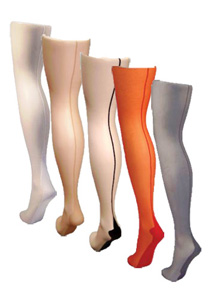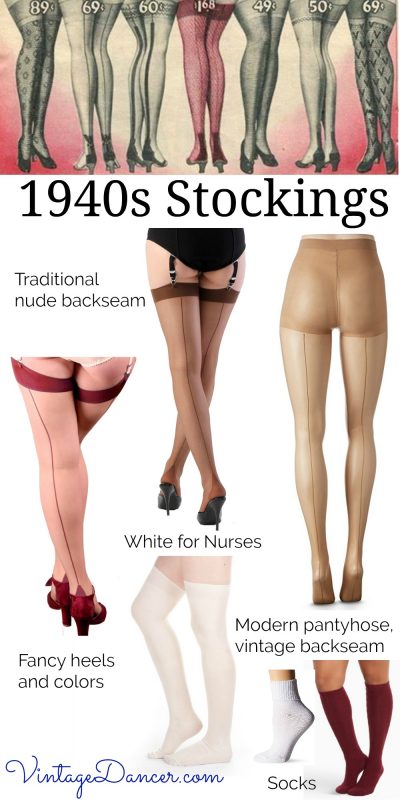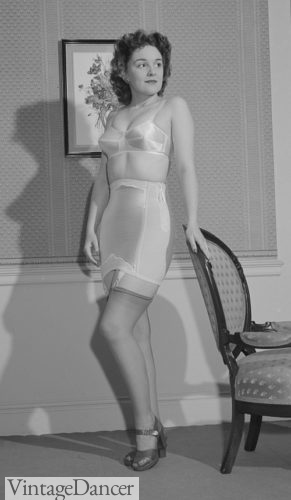
1942 lingerie model at Saks Firth Avenue
Before the 1940s, women would not leave the house without wearing a pair of silk stockings. In fact, it wasn’t considered appropriate to be bare-legged in public whatsoever unless you were at the beach.
WWII shortages combined with the invention of new materials changed the way women purchased 1940s stockings. Stockings, came up to mid-thigh and had to be held up with garters attached to corsets or girdles. A garter belt could also be worn to hold them up. A nude backseam along the back of the leg and heel was a signature, fashionable element on most women’s 1940s stockings.
Stocking were sold by in foot size and three lengths- 28, 30 and 32 inches. Extra long stockings were made for tall women or those who wanted more thigh coverage. Plus size stockings (called outsize) were available in wider leg sizes too.

1941 Plus Size Nylons by Lane Bryant
Before the late ’30s, fabrics weren’t elasticized, so they weren’t very stretchy. Hose were woven into the silhouette of a leg, a process called Fully Fashioned, or on tubular knitters (less common).
Once Rayon and Nylon were invented, stockings began to be made from these instead. They looked like silk stockings but without a heavy shine. They were touted as a “new product which will give women sheer, ringless hosiery that will not wrinkle, run or wear out.”
While not entirely snag-proof, they did snag less and run less, meaning they would hold up longer than silk, depending on the thickness and type of weave.
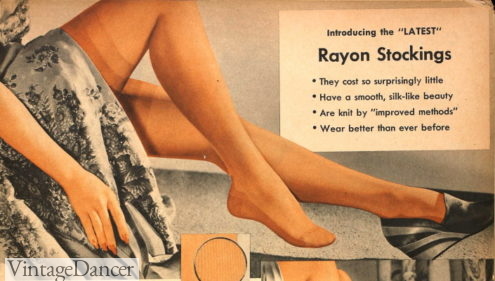
1942 Rayon sheer hosiery
Most 1940s stockings had matching seams up the backs where fully fashioned styles were sewn together. True seamless stockings came about in the late 1940s but never fully took off in fashion till the 1960s. Women wanted the noticeable backseam, even though they were tricky to keep straight.
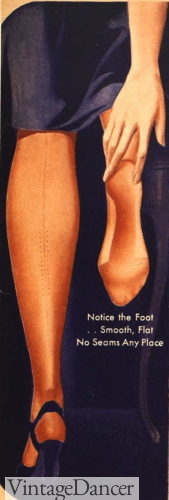
1941 “seamless” stockings were not actually seamless, only less visible then an intentional backseam
Stockings had reinforced toes and heels with a Cuban heel design on most. Cuban heels were a square edge block of darker reinforced knit that could be seen above the shoe heel. While certainly fashionable, they were mostly a practical design.
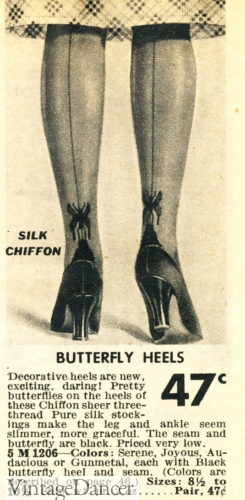
1940 novelty butterfly backseam cuban heel stockings
1940s Hose History
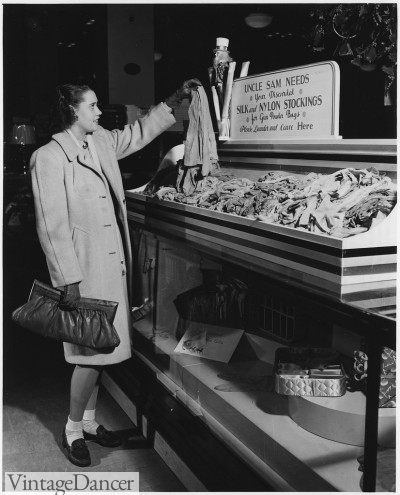
Sign reads “Uncle Sam needs your discarded silk and nylon stockings for the gun powder boys. Please launder and leave here.” Notice the woman wearing socks instead of hose.
During the war, any available silk, nylon, and sometimes Rayon were needed to make parachutes, tents and other fine materials. Women were asked to donate their used stockings to the war effort.
Once word got out that there might be a shortage of Silk and Nylon stockings, women flooded the stores, buying up all they could and thus creating a drastic inflation of pricing.
Once the war board stepped in to regulate production and cap prices, demand settled down, but they generally were still too expensive for women to afford to replace often.
1940s stockings became a precious commodity. They snagged and tore easily, and it was hard to keep a pair around for a long time. Women had to conserve their stockings for very special occasions, and fought over any that might be available for purchase. Most of the time, they had no choice but to go bare-legged. Women didn’t like this.
To wear stockings, especially with seams, was just part of their wardrobe. During the war, however, Sundays were often the only days women wore their stockings. The government went so far as to ask churches to tell women it was alright to attend without stockings.
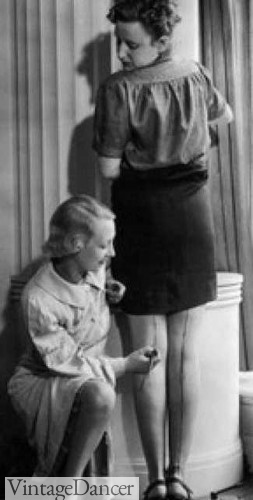
Drawing on Nylon seams with the help of a friend
To get the 1940s nylon look without hose, women began to stain their legs with brown household items like gravy browning, coffee, and cocoa powder to give the appearance of stockings.
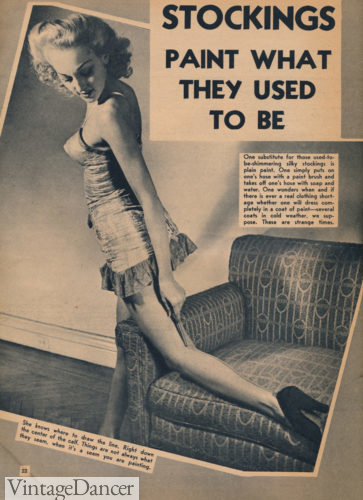
“These are strange times” – 1943
Soon enough leg cosmetics were developed that stained the legs a tan color – sort of the first self-tanners. The first versions stained dresses and ran off in the rain. Newer versions were better, and came in liquid, cream or powder that was mixed with water. Several different shades were usually offered to complement different skin tones.
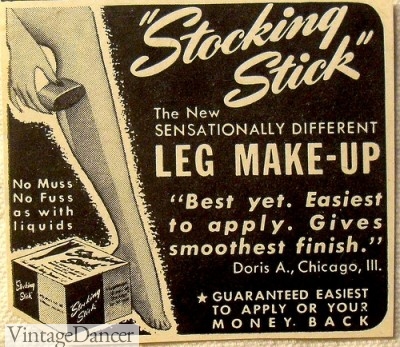
1940s “Leg Makeup”
All of the makeup companies, such as Max Factor and Elizabeth Arden, got on board. Some women took it a step further and drew a ‘seam’ on the backs of their legs with brown or black eyebrow or eyeliner pencil, often enlisting the help of a friend to get it straight.
After the war, Nylon stockings returned and women went right back to wearing them. Du Pont announced immediately after the war that Nylons would be made again for the public. They had some production issues and underestimated demand, so for over a year crowds mobbed stores, creating “nylon riots” every time a shipment came in.
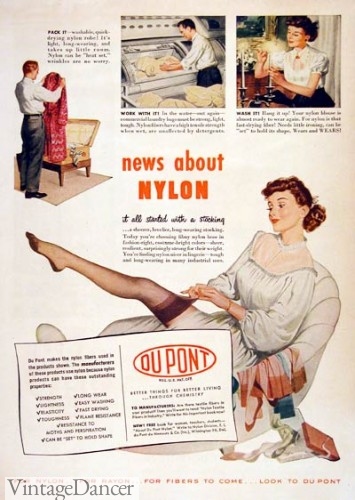
1948 Du Pont Nylons ad
Types of 1940s Stockings
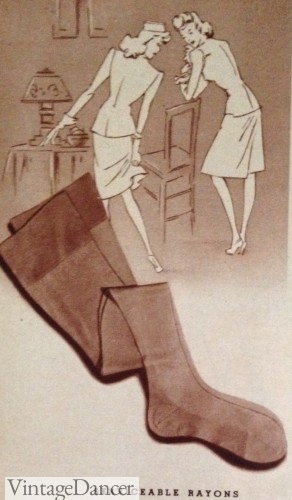
Service or work wear Rayon stockings
There was little variety in stockings in the 1940s. The differences were in the minute details. Silk, Nylon, Rayon, Cotton and Wool were the main types of materials. With Silk and Nylon being in short supply, most women chose Rayon or Cotton stockings.
Rayon could be high shine like silk, or low shine like cotton. It breathed well and held up nicely against wear. Its one drawback was that it lacked any stretch, making the perfect fit harder to achieve.
(I once bought a pair of vintage fully fashioned stockings, and with my small foot but wide calf, they were horribly uncomfortable. They bunched and ripped on the first wear. Thank goodness for modern improvements to hosiery since the 1940s!)
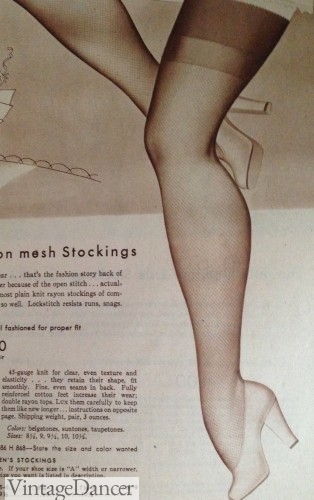
1944 Light Mesh Stockings
There were three main types of textures 1940s stockings came in.
- Smooth– most stockings are knit smooth with some sheerness.
- Mesh- small holes make stockings breath easier and were ideal for work or sports wear.
- Novelty mesh– are unique patterns knit into a stocking for fashion aesthetics only.
The weight, gauge, or thread count of stockings also contributed to texture. For the day or workwear, a heavy knit cotton or wool stocking (similar to tights today) was the most practical.
Heavy “sport” knit stockings were plain or fancy designs of rib stripes or zig zags.
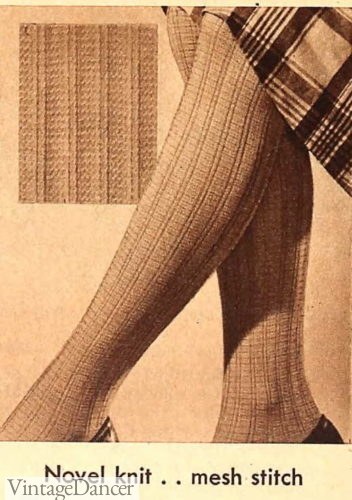
1943 mesh knitted stockings
Office work and afternoon wear could be a medium gauge smooth Rayon stocking, while evening and special occasion wear preferred sheer “chiffon weight”, almost see through, knits.
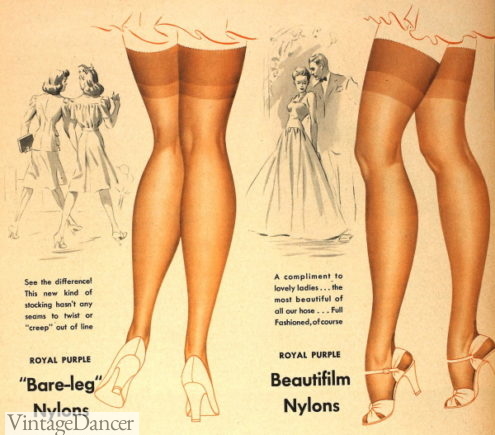
1942 day and evening sheer stockings
1940s hosiery colors were limited to a few shades of a “natural” skin tones, black, and white. Natural colors were called “Beige” for your everyday wear,”Suntones” for a summer sunkissed golden tan, and a “Taupe” that was darker than most white skin tones and often blended with grey threads for special occasions.
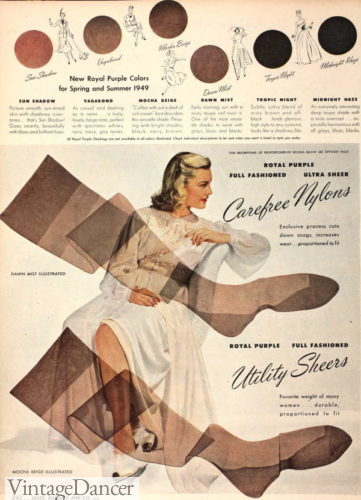
1949 stockings- suntan to taupe or navy blue-black
Darker colors made legs look thinner. White stockings were mostly worn by children, teens, women dressing for weddings, with spring pastel colors, and for certain work uniforms (nurses).
African-American, Caribbean, and Latina women whose skin tones were richer than Taupe had the choice to wear any color of stocking they liked. Women could be seen in black stockings, tan stockings, or white stockings that complimented a white or pastel dress. Most women chose a shade of tan that lighten the legs.
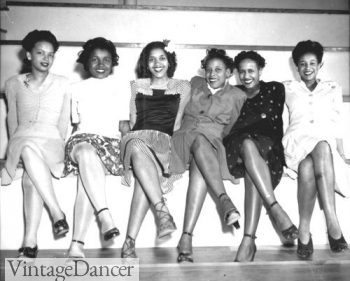
1944 African-American Ladies in Various Stockings Hues
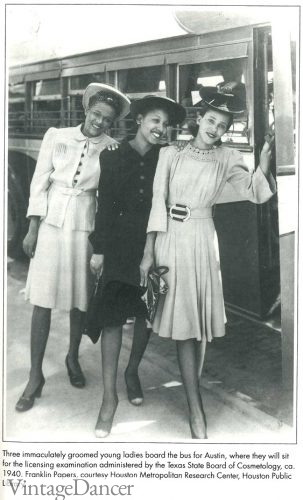
1940, three ladies going to take their cosmetology exams in dark to light stockings.
Read about 1950s women’s stockings next.
1940s Winter Stockings
Winter was a time to put some fashion trends aside in favor of warmth. Winter weight stocking were heavy knits of cotton, rayon, and wool. They were often double layers with cotton on the inside and shiny rayon on the outside. Some were even fleece lined for extra softness. The warmest were all wool stockings.
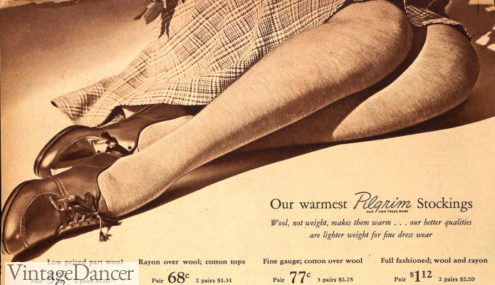
1943 winter weight wool stockings
A wide ribbed band at the thigh was attached to garter straps to hold them up. The texture of the knit leg could be fine and smooth, ribbed, or woven into an interesting mesh.
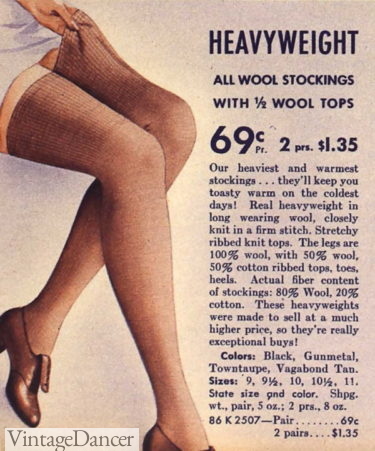
1941 wide ribbed thigh
Winter stockings usually did not have backseams, although some did. Common colors were darker hues of black, taupe, tan and gunmetal grey.

1941 wool winter stockings
Summer Stockings
For under skirts and pants, an over the calf pair of stocking socks was the coolest options outside of being bare legged or short socked. A pair of knee high stockings fit up and over the calf and secured under the knee with a narrow band of elastic.
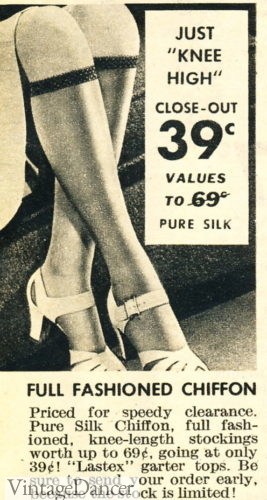
1940 Knee High Stockings
For all the talk to women wearing stockings in any weather, in very hot climates, many women chose to go without. A good suntan or leg makeup tan did a decent job of hiding unsightly leg hair. Being bare legged was only tolerable in informal outfits. Church, brunch, dinner parties, and outings to the “city” required women to wear sheer stockings, no matter hot hot and humid.
Wearing 1940s Stockings
To get your seams straight, roll your stockings down, then pull on your stockings from the front and back, guiding the seam with your right thumb. Most women pull stockings on from the sides, but this will only make getting the seams straight more difficult.
Care for stockings:
- Put lotion on the rough spots of your heels and feet at night so they won’t snag your hose.
- Wash by hand in mild soap, rinsing twice, and rolling in a towel and laying flat to dry.
- Repair by mending.
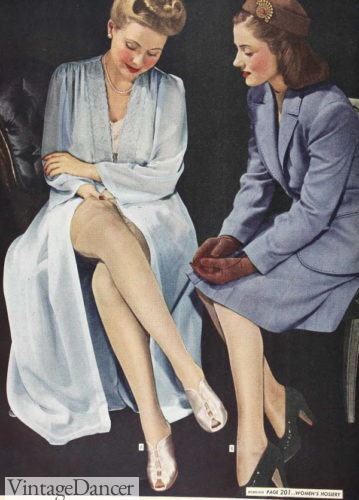
1945 sheer stockings
Buying vintage stockings today gives you more options than in the 1940s. Most women don’t bother to go through the authenticity route of buying fully fashioned, seamed stockings, in Silk or Rayon. They are hard to find, and frankly, just don’t fit as comfortably as modern-does-vintage stretch stockings.
It also doesn’t make too much sense to wear thigh high stockings vs pantyhose when no one will see your thighs under a skirt or dress anyways. However authentic you decide, here are some places to look for 1940s style seamed stockings:
- Retro Seamed stockings – My collection of online sources selling vintage style seamed stockings. I do not recommend black seamed stockings or fancy heel and seam designs- those were not worn until the very late 1940s and were seen more so in the 1950s. Instead, choose a nude skin tone with a nude or tan backseam.
- What Katie Did (UK) and Secrets in Lace (USA) – Both have mostly ’50s style stockings with black backseams. They sometimes have nude back seams in a range of skintones.
- Amazon has a handful of cheap stockings and tights. The Berkshire tonal tights with nude backseam are a best seller. While tights or pantyhose were not worn in the 1940s, they certainly make life easier today.
- Wolford Velvet tights – Nice and cozy for winter warmth, but don’t have back seams. All black.
- Ice skating tights make excellent warm and durable winter nude tights. You can layer a thin backseam stocking over them for the 40s look.
- Snag Tights– I hear great things about Snag Tights for curvy women.
Know of other sources? I am always on the lookout. Tell me where you find 1940s style nude seamed stockings in the comments.
1940s Women’s Socks
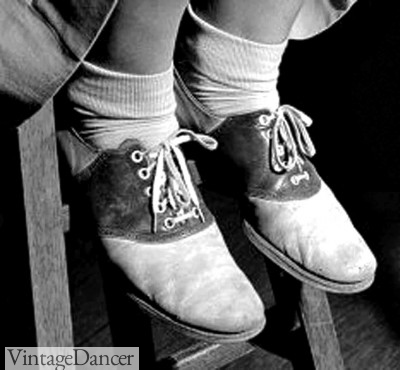
Saddle Shoes and White Anklet Socks
Socks were not often worn by women before 1940, but white and colored ankle socks were very popular with teenage girls. They were proudly worn with saddle shoes or penny loafers.
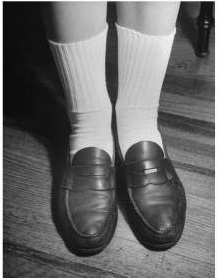
1944 teen socks and penny loafer shoes
Colorful socks were an option for both children and women once the war started. They either had a snug knit band at the top or folded over once for a clean and classy vintage fit. Popular colors were red, white and blue, as well as yellow, beige, light blue, stripes, geometric and argyle prints.
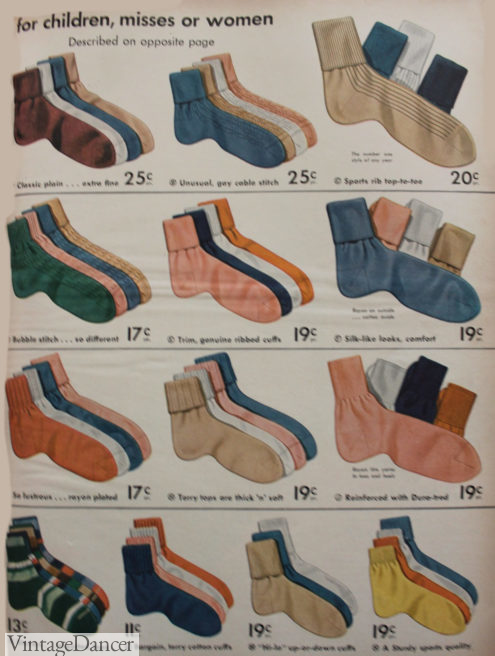
Socks for girls and women
A few fancy socks had small flowers knit into the design that resembled embroidery. For the most part, socks were practical and not a fashion accessory.
During wartime, women conserved their stockings and instead wore ankle socks made of cotton to match their dress. After the war, they returned to stockings and only wore socks for sports and casual dress.
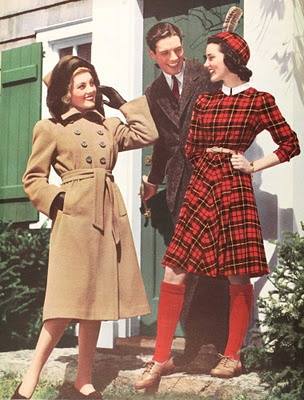
1940s knee high socks worn with flat shoes.
For young women attending college, ankle socks would not be fashionable enough. Instead, tall over-the-calf socks with fold-down tops were in vogue. The tops often featured Nordic designs during winter and flowers in summer. These would be worn just below the knee, usually with the cuff folded back. Many socks were home knitted during this time, with wool yarns being a popular choice.
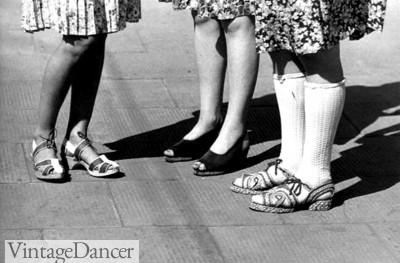
1944 calf high socks with sandals!

1946 school girl outfit
Learn about the history of vintage socks.
Debbie Sessions has been teaching fashion history and helping people dress for vintage themed events since 2009. She has turned a hobby into VintageDancer.com with hundreds of well researched articles and hand picked links to vintage inspired clothing online. She aims to make dressing accurately (or not) an affordable option for all. Oh, and she dances too.
